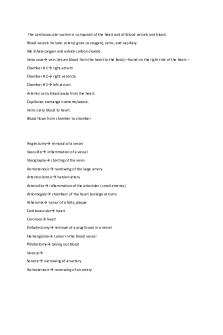Cardiovascular System PDF

| Title | Cardiovascular System |
|---|---|
| Course | Introduction to Health Assessment |
| Institution | University of Regina |
| Pages | 2 |
| File Size | 40.2 KB |
| File Type | |
| Total Downloads | 17 |
| Total Views | 169 |
Summary
Advanced nursing assessment details on the cardiovascular system in preparation for OSCEs. ...
Description
Cardiovascular System 107 Skills Assessment To Begin… wash your hands, introduce yourself, ask patients name, and ask patient “Is it alright if I assess your chest and listen to you heart?” The Precordium 1. Inspection (don’t forget the PMI) a. Shine a light over to accentuate any flicker of movement b. You may be able to see the apical impulse, at the 4th or 5th intercostal space or inside the MC line c. Looking for heaves and lifts
2. Palpation (don’t forget what part of hand and to palpate the pulse for rhythm) a. Palpate the apical pulse using 1 finger pad i. The apical pulse is located in the fifth intercostal space midclavicular line ii. Amplitude: normally a short gentle tap iii. Duration: normally short and occupies the first half of systole iv. Ask patient to exhale and then hold it (aids the examiner in finding the pulse) v. If you cannot find the pulse you may need to roll the patient over vi. Palpating for thrills, which is a palpable vibration
b. Palpate across the precordium i. Using the palmar aspects of your fingers palpate over the apex, LSB, and base ii. Looking for any other pulsations. If they are felt, note the timing, you can do this auscultating while palpating
3. Auscultation (know land marks, valves, and S1-S2) -Note the rate and rhythm, heart rate ranges from 60-100 beats per min. The rhythm should be regular. Note any murmurs if auscultated. -Before you begin alert the patient…. “I always listen to the heart on a number of places on the chest. Just because I am listening a long time, it does not necessarily mean that something is wrong.” a. First Auscultate the Aortic Valve i. Begin at the sternal notch and slide you fingers down to the manubrium and then to the right of the sternum onto the second rib ii. The Aortic valve is located just below the second rib in the second intercostal space, right sternal border. S2 is heard loudest here at the base
b. Second Auscultate the Pulmonic Valve
i. Move your diaphragm directly across to the left side of the body ii. The pulmonic valve is located in the second intercostal space, left sternal border, S2 is heard loudest here
c. Third Auscultate Erb’s Point i. Move diaphragm down one intercostal space ii. Erb’s point is located in the third intercostal space, left sternal border, S1-S2 are heard equally
d. Fourth Auscultate the Tricuspid Valve i. Move your diaphragm down two intercostal spaces ii. The tricuspid valve is located in the fifth intercostal space, left sternal border, S1 heard loudest here at the apex
e. Lastly Auscultate the Mitral (bicuspid) Valve i. Move your diaphragm over to midclavicular line ii. Mitral Valve is located in the fifth intercostal space, S1 heard loudest here
-if I noticed something irregular I would check for a pulse deficit by auscultating the apical beat while simultaneously palpating the radial pulse. -if I heard a murmur I would grade its loudness, time it, describe the quality, location and at what posture it is heard in
Importance of S1 and S2
S1 is heard loudest at the base (top of the heart)
S1 is the start of systole and serves as the reference point for the timing of all other cardiac sounds
S1 coincides with the carotid artery pulse
S2 is heard loudest at the apex (Bottom of the heart)
S2 can be splitting
S2 is start of diastole
2...
Similar Free PDFs

Cardiovascular system
- 2 Pages

Cardiovascular System
- 2 Pages

Cardiovascular System
- 12 Pages

Module 5 - Cardiovascular System
- 2 Pages

Cardiovascular System Quiz
- 4 Pages

Cardiovascular System 2
- 13 Pages

Cardiovascular System MCQ
- 9 Pages

Cardiovascular System Lecture
- 10 Pages

Cardiovascular System Worksheet
- 5 Pages

Chapter 11 Cardiovascular System
- 4 Pages

Ch 18 the cardiovascular system
- 15 Pages

Chapter 5 The Cardiovascular System
- 18 Pages
Popular Institutions
- Tinajero National High School - Annex
- Politeknik Caltex Riau
- Yokohama City University
- SGT University
- University of Al-Qadisiyah
- Divine Word College of Vigan
- Techniek College Rotterdam
- Universidade de Santiago
- Universiti Teknologi MARA Cawangan Johor Kampus Pasir Gudang
- Poltekkes Kemenkes Yogyakarta
- Baguio City National High School
- Colegio san marcos
- preparatoria uno
- Centro de Bachillerato Tecnológico Industrial y de Servicios No. 107
- Dalian Maritime University
- Quang Trung Secondary School
- Colegio Tecnológico en Informática
- Corporación Regional de Educación Superior
- Grupo CEDVA
- Dar Al Uloom University
- Centro de Estudios Preuniversitarios de la Universidad Nacional de Ingeniería
- 上智大学
- Aakash International School, Nuna Majara
- San Felipe Neri Catholic School
- Kang Chiao International School - New Taipei City
- Misamis Occidental National High School
- Institución Educativa Escuela Normal Juan Ladrilleros
- Kolehiyo ng Pantukan
- Batanes State College
- Instituto Continental
- Sekolah Menengah Kejuruan Kesehatan Kaltara (Tarakan)
- Colegio de La Inmaculada Concepcion - Cebu



